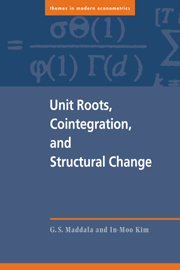Book contents
- Frontmatter
- Contents
- Figures
- Tables
- Dedication
- Preface
- Part I Introduction and basic concepts
- Part II Unit roots and cointegration
- Part III Extensions of the basic model
- 8 The Bayesian analysis of stochastic trends
- 9 Fractional unit roots and fractional cointegration
- 10 Small sample inference: bootstrap methods
- 11 Cointegrated systems with I(2) variables
- 12 Seasonal unit roots and seasonal cointegration
- Part IV Structural change
- Appendix 1 A brief guide to asymptotic theory
- Author index
- Subject index
10 - Small sample inference: bootstrap methods
Published online by Cambridge University Press: 04 August 2010
- Frontmatter
- Contents
- Figures
- Tables
- Dedication
- Preface
- Part I Introduction and basic concepts
- Part II Unit roots and cointegration
- Part III Extensions of the basic model
- 8 The Bayesian analysis of stochastic trends
- 9 Fractional unit roots and fractional cointegration
- 10 Small sample inference: bootstrap methods
- 11 Cointegrated systems with I(2) variables
- 12 Seasonal unit roots and seasonal cointegration
- Part IV Structural change
- Appendix 1 A brief guide to asymptotic theory
- Author index
- Subject index
Summary
Introduction
The inferential procedures that we discussed in the previous chapters are all based on asymptotic theory. The Monte Carlo results presented in chapter 5 (section 5.7) throw light on the small sample behavior of the different estimation methods, but once an estimation method is chosen, there is still the question of appropriate inference on the parameters estimated. The relevant procedures for this are again asymptotic.
Some methods for obtaining small sample results analytically like Edgeworth expansions involve a lot of tedious algebra and are also applicable only in some special cases. The bootstrap method initiated by Efron (1979) provides a viable alternative. Another alternative is to use the Bayesian methods (discussed in chapter 8) but they are based on a different philosophy. Reviews of the bootstrap methods discussed here can be found in Jeong and Maddala (1993), Vinod (1993), Li and Maddala (1996), and Horowitz (1997).
A review of the bootstrap approach
The bootstrap method is a resampling method. Several resampling methods were in use earlier but they were disparate. Efron made the resampling method a widely applicable technique. For a history of the resampling approach going back to early papers by Barnard (1963) and Hartigan (1969), see Hall (1992).
- Type
- Chapter
- Information
- Unit Roots, Cointegration, and Structural Change , pp. 309 - 341Publisher: Cambridge University PressPrint publication year: 1999



